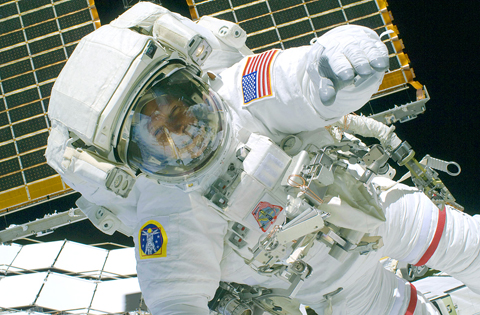The huge solar wings on the International Space Station (ISS) were successfully unfurled on Friday, paving the way for the orbiting laboratory to power up to its full capacity for the first time.
NASA said “no difficulties were encountered” in deploying the wings after astronauts Steve Swanson and Richard Arnold bolted an S6 truss to the space station on Thursday to hold panels forming the fourth and last solar antenna.
The payload is one of the final tasks of the more than decade-long effort by 16 countries to build the US$100 billion outpost in space.

PHOTO: AFP
Once activated, the solar array will have the capacity to generate 120 kilowatts of usable electricity, enough to power about 42 large homes. The ISS had been producing 90 kilowatts before the addition.
The 14-tonne S6 truss was carried into space by Discovery, which blasted off last Sunday from Florida with a crew of seven astronauts, and the orbiter’s robotic arm was used to lift it out of the shuttle’s bay.
Each solar array set has two wings measuring 35m by 11.58m, for a total span of 73m when deployed, including the truss connecting the two panels and allowing them to pivot as they follow the sun. The four panels — two per wing — contain 32,800 cells that convert sunlight into electricity.
Once deployed, the panels provide the power the space station needs to carry out scientific experiments planned by the European Columbus laboratory and the Japanese Kibo laboratory.
The space station will also be able to double the size of its crew from three to six, beginning in May.
During their spacewalk, which lasted 6 hours, 7 minutes, Swanson and Arnold also plugged in power and data connectors and prepared the panels, which had been collapsed like an accordion in a container aboard Discovery.
The next space walk was planned for last night by Swanson and fellow astronaut Joseph Acaba, and was scheduled to last 6 hours, 30 minutes.
The two are due to remove two batteries from a part of the space station that will then be replaced during the next shuttle mission in June.
A third spacewalk has been planned for later in the mission.
In all, NASA has scheduled nine shuttle flights through next year to complete the construction of the space station.
Upcoming shuttle flights also include the last mission to service the orbiting Hubble telescope in May.
Discovery is scheduled to land back on Earth on Saturday, two days after a Russian Soyuz mission takes off for the ISS carrying a crew of three, including US billionaire businessman Charles Simonyi, who has shelled out US$35 million for his second trip as a space tourist.
The Discovery mission, delayed five times, is the first by a US space shuttle this year.
It has been a near picture-perfect mission so far, barring the delayed lift-off and some pesky space rubble that had US and Russian experts braced to move the ISS in an “avoidance maneuver.”

The CIA has a message for Chinese government officials worried about their place in Chinese President Xi Jinping’s (習近平) government: Come work with us. The agency released two Mandarin-language videos on social media on Thursday inviting disgruntled officials to contact the CIA. The recruitment videos posted on YouTube and X racked up more than 5 million views combined in their first day. The outreach comes as CIA Director John Ratcliffe has vowed to boost the agency’s use of intelligence from human sources and its focus on China, which has recently targeted US officials with its own espionage operations. The videos are “aimed at

STEADFAST FRIEND: The bills encourage increased Taiwan-US engagement and address China’s distortion of UN Resolution 2758 to isolate Taiwan internationally The Presidential Office yesterday thanked the US House of Representatives for unanimously passing two Taiwan-related bills highlighting its solid support for Taiwan’s democracy and global participation, and for deepening bilateral relations. One of the bills, the Taiwan Assurance Implementation Act, requires the US Department of State to periodically review its guidelines for engagement with Taiwan, and report to the US Congress on the guidelines and plans to lift self-imposed limitations on US-Taiwan engagement. The other bill is the Taiwan International Solidarity Act, which clarifies that UN Resolution 2758 does not address the issue of the representation of Taiwan or its people in

US Indo-Pacific Commander Admiral Samuel Paparo on Friday expressed concern over the rate at which China is diversifying its military exercises, the Financial Times (FT) reported on Saturday. “The rates of change on the depth and breadth of their exercises is the one non-linear effect that I’ve seen in the last year that wakes me up at night or keeps me up at night,” Paparo was quoted by FT as saying while attending the annual Sedona Forum at the McCain Institute in Arizona. Paparo also expressed concern over the speed with which China was expanding its military. While the US

SHIFT: Taiwan’s better-than-expected first-quarter GDP and signs of weakness in the US have driven global capital back to emerging markets, the central bank head said The central bank yesterday blamed market speculation for the steep rise in the local currency, and urged exporters and financial institutions to stay calm and stop panic sell-offs to avoid hurting their own profitability. The nation’s top monetary policymaker said that it would step in, if necessary, to maintain order and stability in the foreign exchange market. The remarks came as the NT dollar yesterday closed up NT$0.919 to NT$30.145 against the US dollar in Taipei trading, after rising as high as NT$29.59 in intraday trading. The local currency has surged 5.85 percent against the greenback over the past two sessions, central